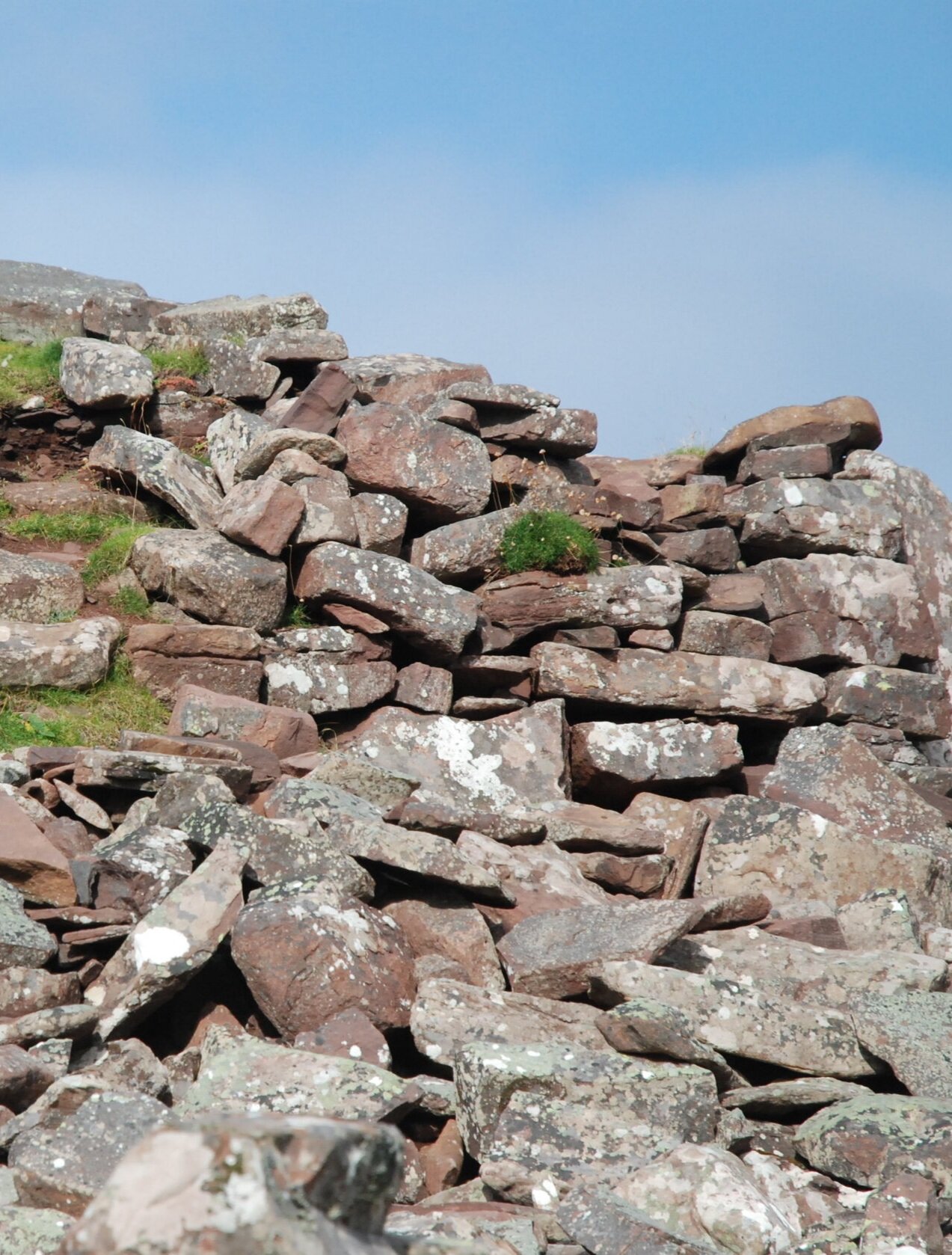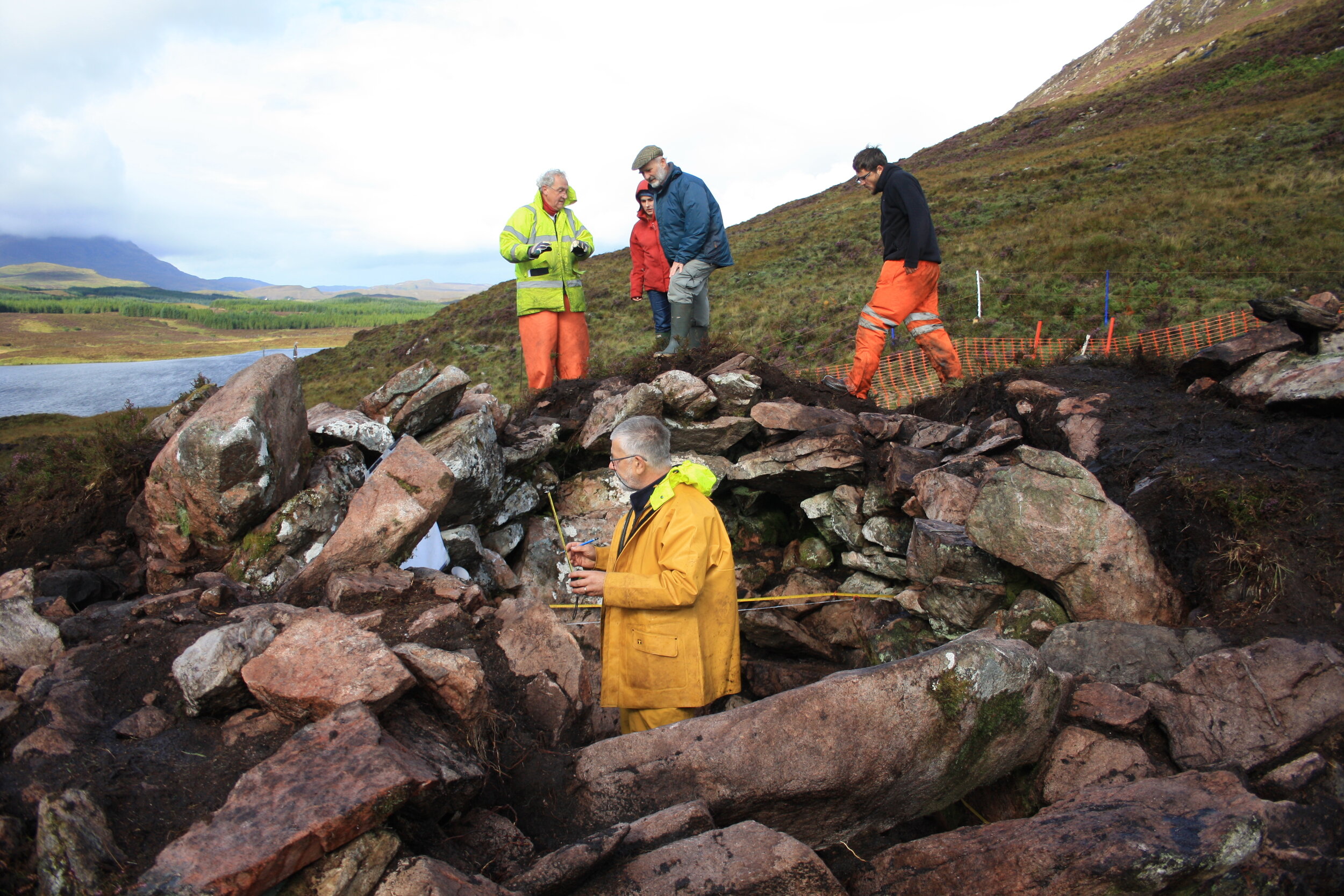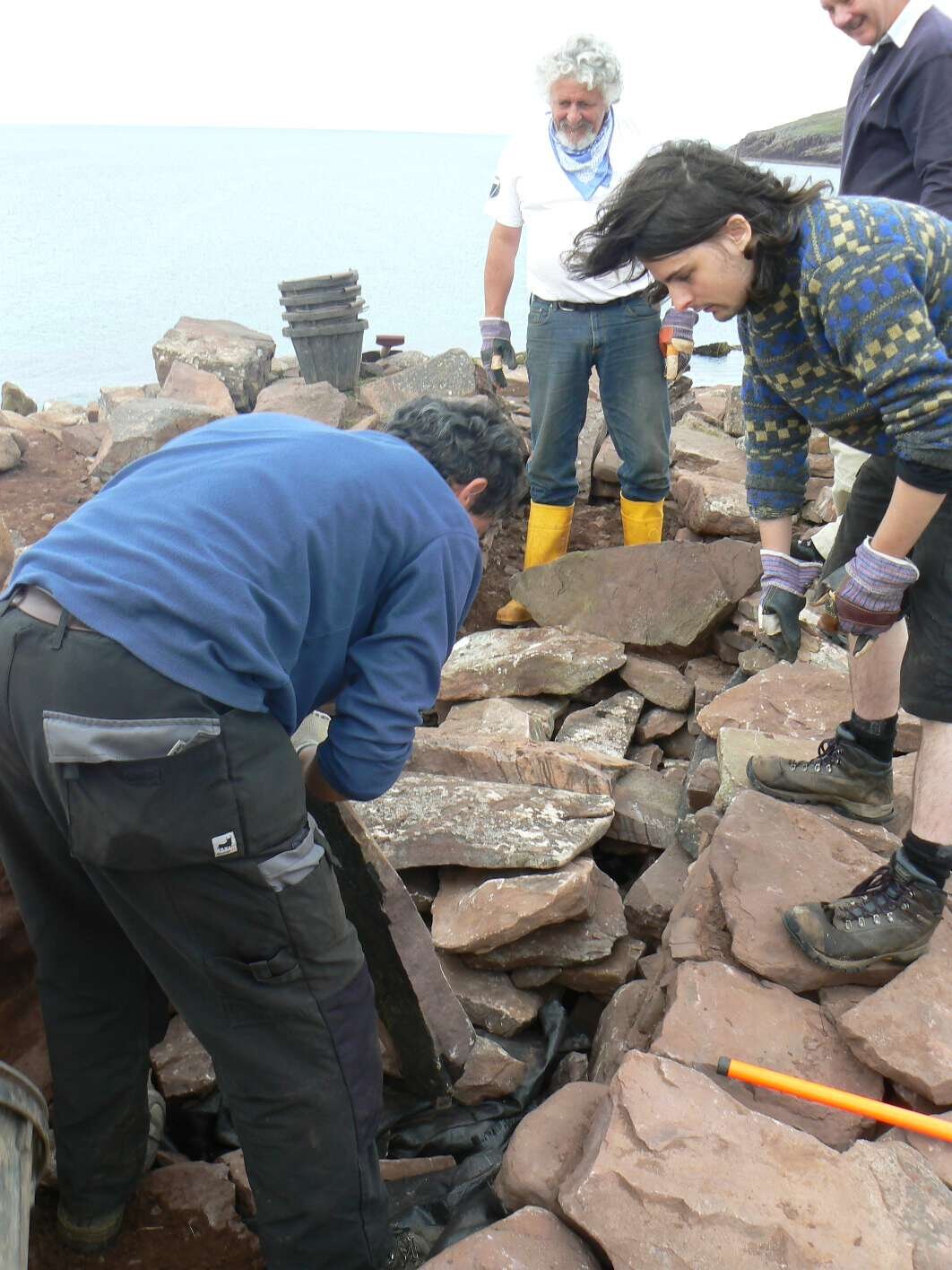
By the early years of this century, Clachtoll Broch was moving ever closer to collapse
Until local community group Historic Assynt stepped in
Historic Assynt project leader Gordon Sleight reflects on the journey
Lots of people enjoy clambering around ruins…
Especially if the ruins are unprotected and lie beside a well-used coastal path dominated by a mound of rubble spilling down from a rocky outcrop.
A clamber over the loose rubble to the top of the mound reveals half blocked entrances and passages which invite further exploration and the end result is that loose stonework gets dislodged and the surviving remains destabilised. Add in winter gales whipping up huge waves which crash over the ruins, animals taking shelter in the recesses or burrowing into the softer material and, as stonework shifts, the whole structure becomes less safe. Exposed walling and precariously balanced lintels can fall suddenly and without warning. Anyone caught in such a collapse could be seriously injured or even killed.
The ruins of Clachtoll Broch, which stand sentinel over Stoer Bay in Assynt on the exposed west coast of Sutherland, were in precisely that situation in the early years of this century. Local concerns were brought to the Assynt Community Council where it was suggested that Historic Assynt be asked to investigate what might be done. They had developed some experience of this kind of work having been set up in 1998 to conserve the ruins of Ardvreck Castle and Calda House and restore the former Parish Kirk in the medieval heart of Assynt at Inchnadamph. That project was drawing to an end (completed in 2008) and they had begun to turn their attention to understanding more about the wider archaeological heritage of Assynt. They had no thought of moving straight into another major project but agreed to jointly sponsor a public meeting with other concerned groups. That meeting revealed widespread worry about the safety of the broch and of its visitors, but also a hope that any eventual conservation work might provide an opportunity to discover more about the broch’s origins and use, and to improve public access and understanding. The meeting concluded that Historic Assynt should seek funding for a feasibility study and so began a close relationship between Historic Assynt and Clachtoll Broch which is ongoing nearly 15 years later!
The feasibility study suggested that the broch’s instability was more serious then realised and this led Historic Scotland (now Historic Environment Scotland) to commission and fund a Conservation Management Plan by AOC Archaeology Group. Their plan highlighted that, despite a minor intervention in the entrance by Historic Scotland in 2001, more work was urgently needed in that area and that other parts of the structure needed conservation in the longer-term. Much of the conservation work they proposed would also expose underlying archaeological material which would need to be simultaneously excavated and subsequently analysed to reveal as much as possible of the broch’s story. The combined conservation and excavation would allow for new access arrangements to reduce the amount of damage caused by people climbing all over the broch.
While all this was going on, Historic Assynt had become a participant in the nationwide Scotland’s Rural Past Project as part of its exploration of the area's wider archaeological heritage. This served to highlight the rich diversity of Assynt’s archaeological heritage but also revealed how little of that heritage had been investigated. Unless more understanding of this wider picture could be gained, the proposed conservation and excavation at the broch would be lacking any comprehensive local context.
By 2008, twin foci for Historic Assynt’s work for the foreseeable future were identified:
To work towards conservation, excavation, interpretation and improved access at Clachtoll Broch.
To explore, survey and record the wider archaeological heritage of Assynt.
Three interrelated professionally-led projects were developed over the next few years and funding secured. ‘Assynt’s Hidden Lives’ surveyed large parts of the most accessible areas of the parish and gave a much clearer overview of the extensive and varied archaeology. It was followed up by ‘Life and Death in Assynt’s Past’ which focussed on excavation and consolidation work at three very different sites in different parts of the parish – the neolithic Loch Borralan East Chambered Cairn, the Iron Age Clachtoll Broch and an 18th century longhouse in the cleared township of Glenleraig. ‘Fire and Water’ completed the trio with excavations at a Bronze Age burnt mound at Stronechrubie and a medieval moated site close to the church at nearby Inchnadamph. The information from all of these projects immensely enriched understanding of Assynt’s wider built heritage and the work at Clachtoll stabilised the dangerous entrance passage and provided valuable insights into the condition of the structure and some intriguing pointers to part of its complex story.
Assynt's Hidden Lives: surveying sites across the parish, whatever the weather
Life & Death in Assynt's Past: recording the interior of Loch Borralan chambered cairn
Fire & Water: excavating a Bronze Age burnt mound at Stronechrubie
The sorts of damage found on the newly exposed stonework around the broch entrance and the patterns of collapse discernible in the rubble of the interior suggested to John Barber and his colleagues from AOC Archaeology Group that the broch tower may have suffered quite a sudden and dramatic collapse which might also have been associated with a fire; charcoal found on an internal ledge provided a date between the mid first century BC and the mid first century AD. It is unlikely that it would have survived undisturbed over the subsequent two thousand years if the broch had ever been re-used, so there was a strong possibility that below the rubble in the broch interior were undisturbed signs of the lives of the last inhabitants.
The conservation work at the broch was followed up by some modelling of the surviving remains of the structure and the associated rubble inside and around it. This work was undertaken by engineering students at the University of Edinburgh under the direction of Dr Dimitris Theodossopoulos and indicated that the rubble in the interior was exerting constant pressure on the surviving broch walls, pushing them outwards with the real possibility of ongoing collapses in the future if that pressure was not relieved.
The weight of the rubble within the broch was pushing the walls outwards
Without intervention, collapse seemed inevitable
All these findings and many more have been regularly fed back to the local community and their ideas and wishes have also played a part in the eventual design of the current project as reported in the pages that follow.
Involvement with Clachtoll Broch projects has been exhilarating! The excitement of excavation, discovery and the results of post-excavation analysis have more than compensated for the long and often tedious hours of background administration - seeking the necessary permissions and funds, consulting the local community and more widely, dealing with the wide range of inevitable frustrations and stresses that come with major projects of this kind.
Historic Assynt is immensely grateful for the help, support and involvement of a huge number of organisations and individuals over the years, listed below. Many, many thanks to one and all!
Gordon Sleight
Historic Assynt Project Leader
With thanks
Any acknowledgements must, of course, include an enormous thank you to all the volunteers who took part in the excavations (without whom we would still be removing rubble to this day), experimental archaeology, finds cataloguing and many other elements of the project. The project’s success is due to the commitment and passion of everyone who gave their time and energy, and to you we extend our gratitude.
Local Superstars
Robin Noble, then chair of Assynt Community Council, who got Historic Assynt involved in the first place and did the bulk of the work for the initial feasibility study
Assynt Crofter’s Trust, Crofter Iain Matheson and subsequently his daughter Katie, for leasing the broch site to Historic Assynt
The many local people who participated in the various public meetings and consultations and whose opinions and concerns have contributed to the development of the project and also those who contributed their skills and time to the wide range of archaeological experiments and public events during the course of the project, especially Marc Campbell and Fergus Stewart
The staff and membership of CALLP, the Coigach and Assynt Living Landscape Partnership, and lead partner the Scottish Wildlife Trust. The 2017 - 2021 Broch Project is just one of many projects within that partnership, and the support and involvement of CALLP has been crucial for the project’s success.
Broch Liaison Officers for both ‘Life and Death in Assynt’s Past’ and the current project: Brenda Gibson, Sharon Bartram, Mandy Haggith, Richard Pease, Roz Summers
Funders
National Lottery Heritage Fund (LDAP and current projects)
Historic Environment Scotland (LDAP and current projects)
SSE Sustainable Development Fund
Pilgrim Trust
Highland Council through the Scottish Communities Landfill Fund
Robert Kiln Trust
Highland Leader (LDAP only )
Private donors
Leadership, Consultancy
and Supervision
AOC Archaeology Group, particularly John, Barber, Graeme Cavers and Andy Heald for their involvement throughout
Brian Wilson, Dimitris Theodossopoulos and all those who have done specialist work like engineering consultancy, coring etc
Architects and fabricators involved in the access provision: Cristina Gonzalez-Longo, Cameron Webster Architects, PLD Smiddy Ltd
HES Officers involved in the regular meetings/consultations




























